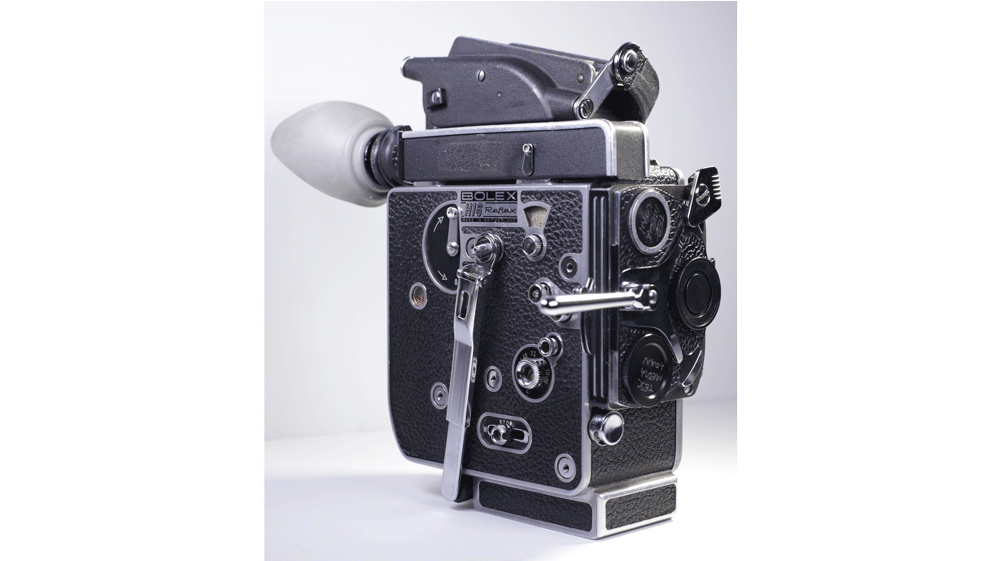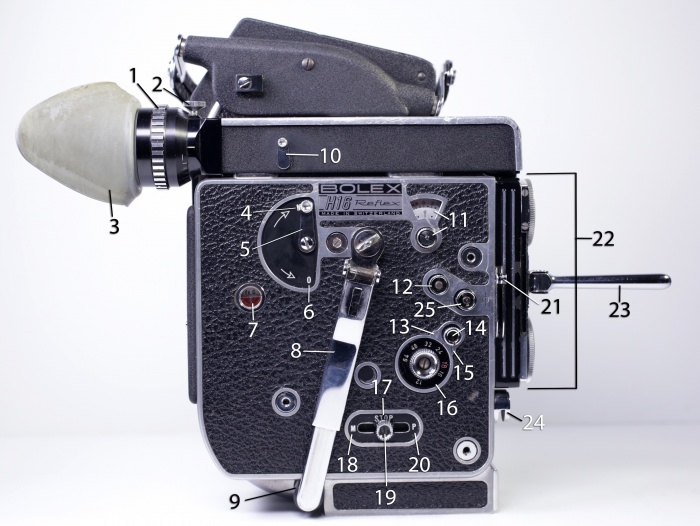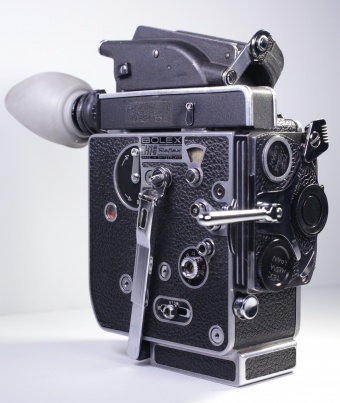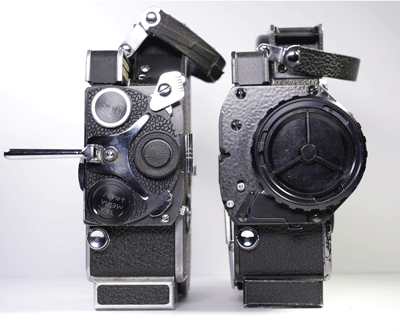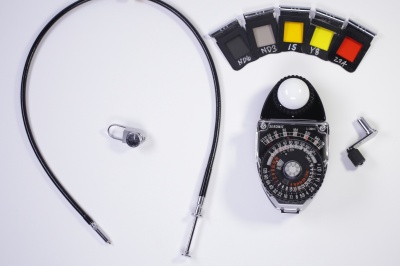APS Bolex 16mm Reflex Operating Guide
Contents
Introduction
Bolex H-16 Reflex Camera Operating Guide PDF
APS Bolex 16mm Reflex Proficiency Test
The Bolex H-16 Rex and H-16 SBM cameras are 16MM reflex cameras. The optical system permits through-the-lens viewing at all times. The self-threading allows easy loading of daylight spools. Camera features include single-frame filming, extended exposure, slow motion, backwind and a 133 ̊-145 ̊ angle variable shutter. Media Loan’s Advanced Production Services (APS) has a variety of Bolex H-16 cameras manufactured between 1960 and 1976. Although all have similar features, the controls vary slightly.
Also available for use with the Bolex cameras are zoom lenses, prime lenses, and an intervalometer as well as other accessories. Care must be taken when using a Bolex because they are expensive and very difficult to replace.
- DO NOT subject the camera to severe impacts or prolonged vibrations.
- DO NOT subject the camera to extreme heat or cold. Drastic temperature changes can cause condensation to occur inside the camera. Let the camera acclimate to the environment you are shooting in by letting it rest in the case with the case tabs opened but the lid closed for at least an hour.
- DO NOT touch the prism.
- DO NOT use excessive force or over tighten anything on the camera.
You are 100% financially responsible for repair and/or replacement in the event of damage or loss of the Bolex, as well as any other equipment checked out from Media Loan.
Viewfinder
The Bolex H-16 viewfinder enables accurate focusing and framing, and allows you to estimate the depth of field.
The reflex prism deflects 20 - 25% of the light passing through the lens into the viewfinder system: only 75 – 80% of the light reaches the film plane. The quality of the light reaching the film is reduced by about 1/2 to 1/3 of an f-stop.
To compensate for the light reduction, Bolex has determined that the effective shutter speed for the H-16 camera is 1/80 of a second rather than the standard 1/65 of a second. Another compensation for the light loss is the RX lens. The RX lens is calibrated to pass 1/2 to 1/3 more light than the aperture markings on the barrel indicates. When using RX lenses with the H-16 camera, the effective shutter speed is back to 1/65 of a second.
APS will provide you with RX lenses (designated after the name on the barrel of the lens), unless you request otherwise or no RX lenses are available. Make sure you know whether or not the lenses you are checking out are RX or non-RX. (Ask an APS employee to show you how to check the lens if necessary.) When using non-RX lenses of 50 mm or less, satisfactory results can be obtained when stopped down to f/8 or smaller.
| Lens Type | 12fps | 16fps | 18fps | 24fps | 32fps | 48fps | 64fps | Single-frame |
|---|---|---|---|---|---|---|---|---|
| Rx | 1/33rd of a second | 1/45th of a second | 1/50th of a second | 1/65th of a second | 1/90th of a second | 1/130th of a second | 1/180th of a second | 1/30th of a second |
| Non-Rx | 1/40th of a second | 1/55th of a second | 1/60th of a second | 1/80th of a second | 1/110th of a second | 1/160th of a second | 1/220nd of a second | 1/40th of a second |
Anatomy
- Diopter
- Diopter lock
- Eyecup
- MOT (engage motor)
- Spring lever
- 0 (disengage motor)
- Footage counter
- Winding crank
- Crank latch (behind)
- Douser
- Frame counter & knob
- Backwind
- Timed exposure
- Extended exposure knob
- Instantaneous exposure
- Frame rate selector
- STOP
- M (continuous)
- Release selector
- P (single frame)
- Variable shutter
- Turret
- Turret arm
- Release button
- Electric motor shaft
Douser
The douser (located on the reflex viewfinder) closes the eyepiece to keep light from reaching and fogging the film plane through the viewfinder. The douser is open when the lever is in the horizontal position and closed when in the vertical position. Close the douser whenever your eye is removed from the eyepiece to prevent film from fogging.
Diopter Adjustment
The diopter adjustment corrects the optical system to the operator’s eyesight and remains the same for all lenses on the camera. If you wear glasses, you can adjust the diopter to your eyesight and achieve accurate focus without your glasses. Always set the diopter to your eyesight (before filming).
To set the diopter:
- Turn the turret to expose the reflex prism (no lens in the taking position) or remove the cover of the bayonet mount.
- Point the camera at a light source.
- Unlock the diopter adjustment either by loosening the grooved ring around the viewfinder or the locking screw depending on the camera model.
- Adjust the viewfinder until the grain of the ground glass is perfectly sharp.
- Lock the diopter finger tight, but DO NOT OVER-TIGHTEN.
Turret Mount
You can change from one lens to another easily by turning the turret. To turn the turret, be sure to use the silver fold away lever rather than handling the lenses. Doing so lessens the risk of accidentally changing the aperture and/or focus ring – or damaging the lenses and/or camera.
When using heavier lenses, such as telephoto or zoom lenses, the turret should be locked with a turret plug, marked with a red ring. Turret plugs go into the lowest lens cavity, when turret is in normal position.
For lighter lenses, the turret lock on the camera should be sufficient for stabilizing the turret. This lock is located above the lens in the taking position and should be tightened before the lenses are in place. Place wide-angle lenses and the telephoto lenses opposite of each other on the turret so that the telephoto lens does not interfere with the field of the wide-angle lens. To attach a lens, simply unscrew the turret cap and screw on the lens. You can have up to three lenses mounted at once on the turret mount. If using less than three lenses, make sure turret caps are secured in unused positions. ALWAYS keep loose turret caps and lens caps in the case to avoid losing them.
Turret Mount Filters
Cameras with a turret mount have a filter between the taking lens position and the reflex prism. The filter remains in place no matter which lens is used. When filming without a filter, an empty filter carrier should be left in the filter slot to prevent light from entering the camera through the slot and fogging the film. Make sure the carrier is located firmly within the slot and the correct filter is in place before shooting. An incorrect filter will either alter the color balance or exposure.
Bayonet Mount
The Bolex H-16 SBM camera has a single lens bayonet mount and is recommended for use with heavier lenses.
To mount a lens:
- Turn the outer ring in the direction of the arrow (counter-clockwise if camera is facing you). Press the button on the bottom of the mount to move the screw into the open position where you will se the tabs of the cap.
- Lift the cap out of the mount and immediately place the lens mount in its place. Be careful not to touch the prism!
- Turn the ring clockwise to secure the lens mount in place and screw the lens into place.
To remove a lens and secure the bayonet mount cap:
- Unscrew the lens; replace lens caps and return to lens case.
- Turn outer ring as described above until tabs in lens ring are revealed.
- Remove the lens by pulling it out. DO NOT touch prism with fingers!
- Replace cap and secure by turning lens clockwise.
Bayonet Mount Filters
Filter insertion is from the control side of the camera. When not in use, the filter should be left in the storage position with the lever folded down and locked. To insert a filter: 1. Slide the button down and insert the filter into the filter slot with the notched side down. 2. The first position is where the filter can be stored until needed. Fold the handle down and secure in notch. To use the filter, it must be inserted all the way in to the filter slot so that it is in between the lens and the prism. 3. From the storage position, unfold the lever. Slide the button down and continue inserting the filter until it’s all the way in.
Film Speeds
The camera has film speeds ranging from 12 to 64 frames per second, except for the H-16 Reflex (the earliest model) which also has a setting for 8fps. To select the desired film speed, turn the control knob until the corresponding figure is opposite the red dot. When changing filming speeds, do not forget to alter exposure setting. (When changing from 24 to 48 by one stop and so forth.)
Release Selector (AKA Side Release)
The H-16 can be used for normal, continuous or single frame filming. The different operations are controlled by the release selector. Normal – This method is suitable for most shooting situations. The camera runs as long as the operator depresses the front release button or pushes the release selector towards M. Continuous – Push the release selector towards M until it clicks into place. The camera will continue running until the wind runs out or the release selector is pushed back to the STOP position. Single frame – Use a cable release adapter to attach a cable release to the release selector. The adapter should be set so that the cable release pushes the release selector towards the P. Single frame exposures can be set for Instantaneous or Time Release. Turn the knob or lever to I to select Instantaneous. The effective shutter speed is 1/30 of a second. To select Time Release, set the knob’s guide mark or the lever to T. The shutter will stay open for as long as the release selector is set to P.
Camera Motor
The H-16 cameras have a spring drive motor. The motor can be disengaged to backwind the film. Most cameras that are available from APS can be used with a motor and therefore used with the Intervalometer for time-lapse animation or with electric motor for sync sound. To wind the camera:
- Set the disengaging lever to MOT and the release selector to STOP. (If the release selector will not go to STOP, slightly wind the spring.)
- Lift the winding crank, which automatically engages the spindle, and set so that the slot in the handle is secured on the tab.
- Wind the spring counter-clockwise fully without forcing it.
- Fold the crank back and secure it on the latch on the lower body.
Fully wound, the motor will drive about 18 feet of film through the camera (about 28 seconds at 24fps). Important: Never leave the camera wound during storage. This may ruin the spring. When running down the camera with no film loaded, set the film speed at the lowest setting.
Variable Shutter
The H-16 is equipped with a shutter capable of having its aperture varied whether or not the camera is running or stopped. This enables you to reduce exposure time without altering the camera running speed or f-stop. In bright light, the variable shutter can be used to reduce exposure, therefore eliminating the need for a neutral density filter. The shutter may be locked in each of its five positions by pulling it out and pushing in when at the desired setting. The markings on the variable shutter correspond to the equivalent f-stop change (i.e., filming at the 1/2 mark is equivalent to stopping down by 1/2, at mark 2 equals closing down the lens diaphragm by 2 stops.) When the variable shutter is fully closed, no light enters the film plane. Warning: You can still see an image through the viewfinder if the variable shutter is closed. Some cameras show a triangular warning signal, but not all. Make sure you variable shutter is opened to the correct setting when filming.
Footage Counter
The footage counter indicates how much film has been exposed. The counter will automatically reset when the lid is removed and will read FEET.
Frame Counter
The frame counter is helpful for lap dissolves, double exposures and animation. The frame counter adds frames in forward run and subtracts them in reverse. The upper dial counts single frames, 0 - 50. The lower dial totals in units of 50 frames, 0 - 1000.
Loading the Camera
The H-16 has automatic threading and loop forming capabilities making it an easy camera to load. When shooting at 24fps, there is an option for an audible click every second indicating that 8 inches of film has passed through the camera. This can be useful when timing a pan or zoom shot. For an audible click, move the audible signal select lever down when loading film; for no click place the lever in the 0 position.
Before loading the camera:
- Set the release selector to STOP.
- Set the disengaging lever to MOT.
- Set the frame rate to the desired camera speed.
- Wind the camera.
Open the camera lid. Visually inspect the film gate to make sure that it is not dirty. DO NOT use condensed air to blow dust from the camera. Cleaning the gate is a delicate procedure and you can cause irreparable damage if you do not do it correctly. Cameras are inspected and cleaned when they are returned to Media Loan so the camera you check out should be ready for filming. Use care when loading the camera so that you do not inadvertently get hair or debris inside which could ruin your film. Make sure your hands are clean before loading film or otherwise poking about inside the camera.
Loading the Camera
When loading the Bolex, make sure to go through the following steps:
- Check that the pressure plate is locked so that it cannot open. The film will jam at this point if the plate is not closed.
- Close the loop formers by moving the control lever down so that it is parallel to the pressure plate.
- Remove the empty daylight spool from its spindle by pressing the ejector. This will be your take-up spool. (The spool can pop out so block it with your hand.)
- Place the loaded daylight spool on the upper spindle. The film should come off in the direction of the engraved arrow. At the film gate, the emulsion should always face towards the front of the camera.
- Using the film end located at the bottom of the camera, clip the film end.
- Insert film end in the top feed sprocket and start the camera motor by depressing the front release button.
- The film is automatically threaded through the gate. If you need to adjust the film, you can spread the sprocket guides by carefully pushing the sprocket guide in from the sprocket wheels.
- Continue to run the film until about 12 inches have run through the drive mechanism.
- Open the loop formers by pressing the button on the lever located on the sprocket/gate assembly.
- Insert the film end into the take-up spool in the direction of the engraved arrow. Place the spool on the lower spindle and take up any slack by hand.
- Run the camera again for several seconds, listening to make sure the film is threaded properly. Check that the film is advancing properly and that the loops do not scrape the body.
- Replace the lid and lock.
- The footage counter will be reset. Run the camera until the counter reads 0. This indicates the film leader has been taken up and the camera is ready to be used.
Film can be loaded in light, but subdued light is best.
Lap Dissolve
Superimposing a fade-in on a fade-out makes a lap dissolve so that one picture gradually disappears as the next gradually appears. (This is also known as a cross-dissolve.) This allows for a smooth transition during which the picture brightness scarcely varies. To produce a lap dissolve:
- Close the first shot in a sequence with a fade out. When beginning to close down the variable shutter, note what frame you are at in the frame counter. Alternatively, time how long it takes you to reach the closed position from the start of the fade and stop filming.
- Lock the variable shutter in the closed position.
- Disengage the motor by setting the selector to 0.
- Set the release selector to M.
- Close the douser if not already closed by moving it into the vertical position.
- Cap the lens.
- Using the backwind key, rewind the film until the frame counter indicates the duration of the fade out.
- Move the release selector to the STOP position.
- Frame the second sequence to be filmed.
- As you begin filming by pressing the release selector to M, begin the fade in by moving the variable shutter smoothly to the open position.
- Lock the variable shutter into the open position.
The Rex-o-fader is an accessory that can help with smooth fades and is available at APS. Ask an APS employee to show you how to attach and use it if you decide to check it out with a Bolex.
ACCESSORIES
There are many accessory options for the Bolex. You must include these on your APS workorder for them to be added to your reservation as none of these items automatically come with the camera.
- Lenses: wide, standard, telephoto, and zoom
- Light meter: measure the light in a scene to set the proper exposure.
- Backwind: use this to rewind your film in the Bolex for double exposures, etc
- Cable release & adapter: use to take pictures, such as for timelapse animation on the Bolex.
- Filter kit: changes the contrast of a scene, among other effects. See the filter kit guide for a full explanation.

